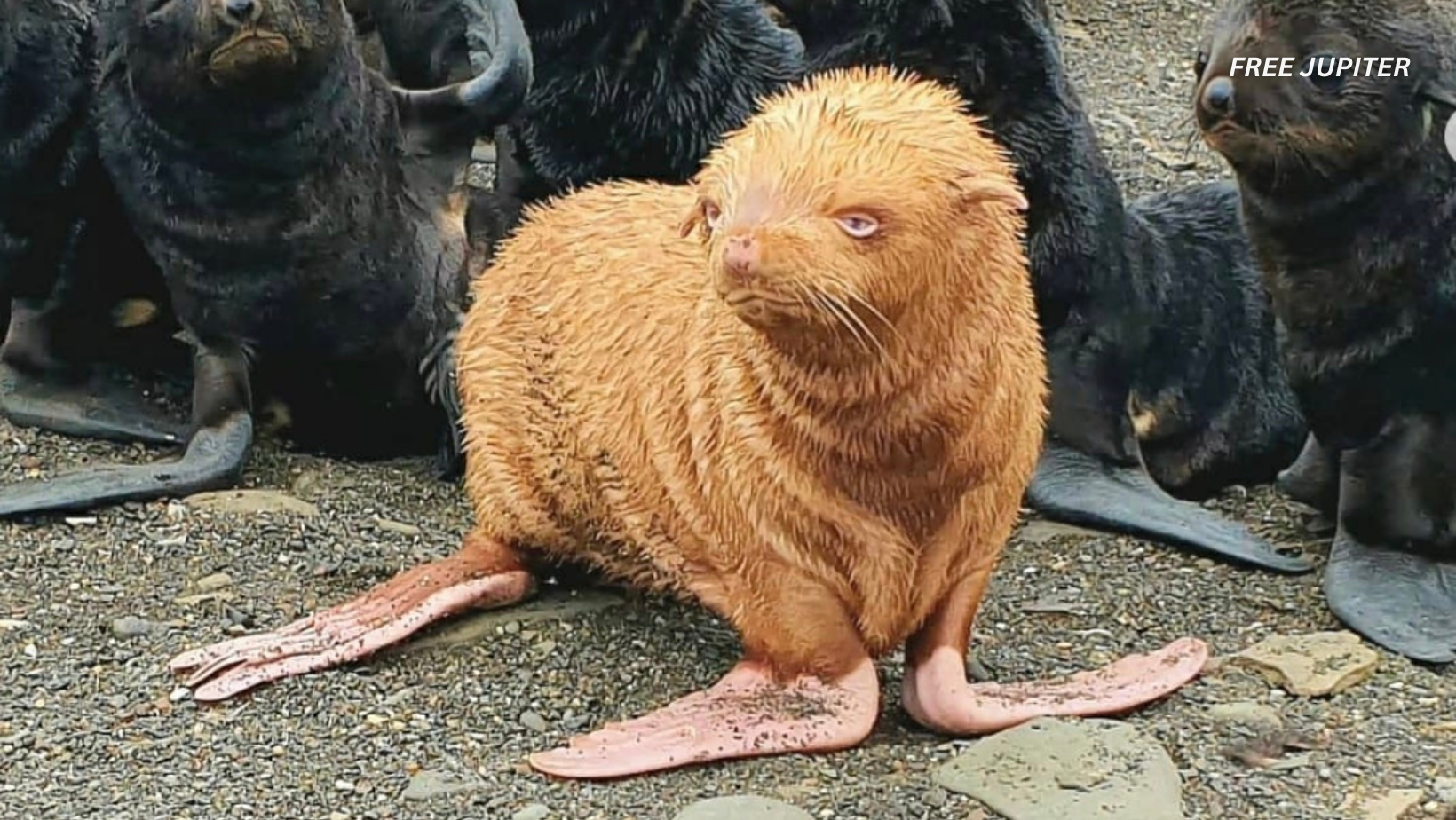Friendly Note: FreeJupiter.com shares general info for curious minds 🌟 Please fact-check all claims—and always check health matters with a professional 💙
A rare ginger albino seal pup has been spotted on Tyuleny Island, located in Russia’s remote Sea of Okhotsk. The tiny marine mammal, born with a striking pale reddish coat and pinkish eyes, stands out from the rest of its colony, and scientists are calling it a once-in-a-lifetime sighting. Marine researchers say that this coloration is the result of albinism, a genetic trait that occurs only once in roughly 100,000 births among seals. This discovery has sparked worldwide interest, not just for its rarity but also for what it could reveal about life in one of the harshest environments on Earth.
Unlike other members of its species that blend into their rocky and icy surroundings, this albino seal pup’s ginger fur and light-colored eyes create a noticeable contrast. Despite its uniqueness, the pup has shown signs of normal behavior, remaining close to its mother and navigating the rugged island environment. However, its distinct appearance may pose significant risks to its survival, making the event both exciting and sobering.
The Island Where Nature Keeps Secrets
Tyuleny Island is not the kind of place most people have heard of. This rugged, wind-swept landmass lies off the eastern coast of Russia. Its name translates to “Seal Island,” which makes sense given that it is home to large colonies of northern fur seals. The harsh, isolated conditions make the island an ideal site for studying seals in their natural habitat. Because human interference is minimal, scientists can observe natural behaviors, interactions, and genetic anomalies like this albino seal pup.
The geography of the island plays a role in preserving biodiversity. It has rocky beaches, steep cliffs, and cold, nutrient-rich waters that support an abundance of marine life. These conditions also mean that only the fittest animals survive. In such a setting, the appearance of a pup with albinism is both miraculous and precarious. Researchers believe that while the island is a sanctuary in many ways, the challenges for an albino seal are very real.
Read More: Australia Is Using 3D Printers To Save Coral Reefs, And The Fish Are Already Moving In
What Albinism Means in the Wild
Albinism is a genetic mutation that results in the absence of melanin, the pigment responsible for dark colors in skin, fur, and eyes. In seals, this usually results in a reddish or yellowish hue, along with very pale or pinkish eyes. These changes are more than cosmetic. In the wild, color often means camouflage, and without it, an albino seal becomes more visible to predators like killer whales or large sea birds. This makes life much more dangerous.
In addition to visibility, albino animals often have other health issues. Vision problems are common, and the pale eyes of this albino seal pup might indicate reduced eyesight. This can affect how it navigates, how it forages, and how it interacts with its environment. Even subtle impairments could mean the difference between survival and death in an ecosystem where precision matters. Still, early signs suggest this pup is adjusting well for now.
The Pup’s Unusual Appearance
The most obvious thing about the pup is its reddish-gold fur. In contrast to the sleek dark brown or gray coats of typical northern fur seals, the ginger coloring looks almost surreal against the island’s volcanic rocks. Its flippers are also lighter, almost translucent, and its eyes lack the deep brown hue common to others in its colony. Despite its visual differences, the albino seal pup appears to be in good health. It suckles normally, follows its mother, and even basks on the rocks like the others.
Scientists observing the pup report that its behavior is typical for a seal of its age. It reacts to environmental cues, avoids dangers, and appears well-fed. These are all positive signs, suggesting that the lack of pigment has not immediately interfered with its development. However, researchers remain cautious. They understand that early success does not guarantee long-term survival, especially once the pup becomes more independent.
Family Matters in a Harsh Environment
One of the more heartwarming aspects of the discovery is that the pup’s mother appears to have fully accepted it. In many species, animals born with visible deformities or differences are often abandoned. This albino seal pup, however, remains under its mother’s care and has not been rejected by other members of the colony. It plays and lounges among the others without being attacked or ignored. This suggests a strong maternal bond and possibly a colony less concerned with visual differences.
It’s important to note that this early acceptance might change. As the pup ages and starts mingling more with unrelated seals, its social status could shift. If it becomes ostracized, it could be forced to fend for itself earlier than normal, putting it at greater risk. For now, though, the animal remains under the protective shadow of its mother, giving it the best possible start in a world where every advantage counts.
Risks of Predation and Visibility
The open reddish tone of the albino seal pup makes it a glaring target. While adult seals are relatively safe from most land predators due to the island’s isolation, the surrounding sea tells a different story. Killer whales, sharks, and large predatory birds patrol the waters and skies. Their vision is tuned to detect movement and contrast. A ginger-colored pup offers exactly that. Unlike its darker peers, it cannot blend into the rocks or kelp as easily.
This puts the pup at risk, particularly when it begins to explore beyond the safety of its mother’s side. During early development, seal pups spend much of their time on land, but eventually, they must swim and feed on their own. If the albino seal lacks visual stealth in water, its chances of evading predators decline. The same visibility that makes it photogenic to us could make it fatal in the wild.
Visual Challenges and Navigational Risks
One lesser-known consequence of albinism is poor eyesight. For many albino animals, the pigmentation in the eyes is crucial for normal visual function. The albino seal pup appears to have light-sensitive eyes, which can cause difficulties in bright daylight or underwater. Since seals rely heavily on vision when swimming and hunting, any visual limitation could become a serious liability.
Early signs suggest the pup may not see as clearly as others. It tends to stay close to its mother, possibly relying more on sound and smell than sight. If this continues, it may struggle when it needs to navigate open water alone. This aspect will be closely watched by researchers who are studying their behavior patterns in the hope of understanding how albino animals cope in nature.
The Role of Monitoring and Research
This rare sighting has given researchers a rare chance to observe how albinism plays out in a natural setting. Rather than being held in captivity, the pup is in its wild, untamed environment. This allows scientists to gather real-time data on its survival rate, social behaviors, and adaptive strategies. These observations could help inform future conservation work focused on genetic anomalies in wild populations.
Monitoring this albino seal over time will also contribute to our understanding of seal colonies and how they handle genetic diversity. It could reveal whether albinism causes long-term social or reproductive disadvantages. This kind of knowledge can shape how researchers manage protected areas and wildlife policy, especially in regions where certain animal populations are already under stress due to climate change or human interference.
Read More: Human Eyes Have Only Seen 0.001% of the Seafloor
Albinism in the Animal Kingdom
Although rare, albinism appears in many animal species, from deer and birds to reptiles and marine creatures. Each species reacts differently to this condition. Some albino animals do surprisingly well, while others face rejection and early death. The ginger albino seal pup is part of this broader biological puzzle. Its story can shed light on how traits outside the norm influence survival.
In some cultures, albino animals are considered sacred or symbolic. Their unusual appearance can evoke fascination and curiosity. But in the wild, these animals face more practical challenges. Understanding how albinism affects not just appearance but function is crucial to conservation biology. This pup could play a small but important role in unraveling that mystery.
Human Fascination and Ethical Watching
Photos and videos of the albino seal pup have already circulated widely online, fueling public interest. The seal’s charming looks and touching story have struck a chord with people around the world. However, scientists urge caution. Increased attention can sometimes bring unwanted human interference. While this island remains remote, the rise of eco-tourism or amateur wildlife filming can disturb sensitive habitats.
Responsible watching is the key. The best way to support this animal is to allow it space and time. Nature works best when left uninterrupted. Scientists working on Tyuleny Island follow strict protocols to minimize human impact. They use long lenses, observe from a distance, and avoid direct contact. This ethical approach ensures that the data they collect is reliable and the animals remain safe.
A Symbol of Genetic Wonder
The albino seal pup has quickly become a symbol of rare genetic wonder. Its appearance challenges assumptions about what is normal and shows the diverse range of outcomes nature can produce. It is a reminder that even in isolated places, nature has surprises in store. This tiny creature, just weeks old, is already reshaping conversations about genetics, conservation, and animal behavior.
Its story also serves as a metaphor. In a world obsessed with sameness and predictability, the ginger albino seal pup represents the beauty of biological variation. Not every organism fits into the mold, and that is not a flaw. It is a feature of life’s vast tapestry. From a scientific standpoint, every anomaly holds a lesson. From a human standpoint, it holds a spark of awe.
The rare ginger albino seal pup spotted on Tyuleny Island is more than just a photogenic oddity. It is a living case study in how genetic diversity, environmental pressures, and social dynamics interact in the wild. With its unique appearance and uncertain future, the pup challenges researchers to think deeper about how nature adapts and evolves.
As scientists continue to monitor the albino seal, the world watches with fascination. Whether it thrives or struggles, the story is already an important one. It tells us something fundamental about resilience, difference, and the quiet drama that unfolds far from human eyes. The albino pup may be rare, but the questions it raises are universal. And for that reason alone, it deserves our attention and our care.










